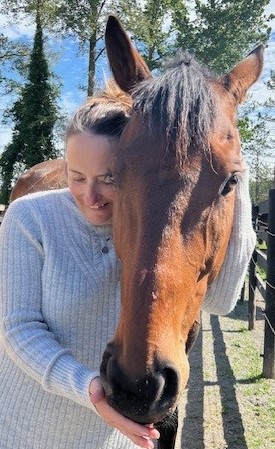Equine Connection Benefits ADHD Individuals

As a parent unfamiliar with horses, I was eager for my ADHD child to experience the excitement and connection of riding without delving into the intricacies of horsemanship. Little did I know, those seemingly mundane tasks were just as important, if not more so, than soaring over jumps. Fast forward a decade, and here we are, deeply entrenched in the world of horses and the equine community.
The Whole Experience: More Than Just Riding
When new to horses, most will think the value is in how much saddle or “jump time” one has; however, contrary to this belief, the magic of horses transcends mere saddle time. It is like the wisdom imparted in the ‘wax on, wax off’ scene from Karate Kid – every action, no matter how seemingly trivial, contributes to the holistic experience. Each moment spent with these large animals is a form of connection, meditation, and self-therapy for the individual and their equine companion. The process of grooming (brushing) and caring for the horse, knowing how the horse is feeling, watching movements and reactions for well-being, and taking the time to prepare for the ride is as valuable as the time spent riding. Being around horses is about making that emotional connection and observation.
The Science Behind Horses and the Human Connection
You will often hear phrases in the equine community such as “Horses are therapy, help with anxiety, will keep kids away from trouble, are great for mental health and confidence”, and the list goes on. This is not just anecdotal; scientific research supports the therapeutic benefits of horse interaction. Studies have shown that the rhythmic motion and calming presence of horses can alleviate symptoms associated with various conditions, including ADHD. The research is limited, and more validated evaluations are needed to explore the extent of these benefits.
How Horses Aid in Managing ADHD
Calming: The rhythmic stride of a horse induces a profound sense of tranquility, fostering a harmonious bond between rider and horse. Whether on the ground or in the saddle, maintaining a state of calmness is important, as horses are keenly attuned to human emotions, mirroring their responses accordingly. The intimate ritual of grooming, characterized by gentle strokes and meticulous care, further increases this sense of calmness. Even seemingly mundane tasks like sweeping and stall-picking can serve as therapeutic outlets, grounding individuals in a state of mindfulness. Studies have shown that the presence of horses correlates with reduced stress levels and heart rates in humans, attributed to the electromagnetic field generated by their hearts.
Enhanced Focus and Organization: Engaging with horses requires mental and physical coordination, fostering skills in focus and organizational abilities. From grooming to riding, individuals learn to prepare, focus, anticipate, and adapt, honing essential executive functions important for managing ADHD symptoms.
Building Connections: Horses, like humans, thrive on mutual trust and respect. Interacting with these perceptive animals teaches individuals with ADHD to regulate their energy levels and interpret nonverbal cues, essential skills often challenging for neurodivergent individuals. The non-judgmental feedback provided by horses fosters emotional growth and self-awareness.
Getting Started
Developing connections with horses can yield numerous advantages, whether you’re in the saddle or interacting with them on the ground. Opportunities to engage with these large animals come in many forms, from formal lessons to casual visits to nearby farms. Just being in their presence can be therapeutic, making it accessible even if you’re on a tight budget. Offering to volunteer for tasks like stall cleaning or grooming can also be incredibly rewarding.
Formal disciplines that utilize equine therapy are: therapeutic horseback riding, hippotherapy, equine-assisted learning, and equine-assisted psychotherapy. As we continue to unravel the benefits of equine therapy, one thing remains certain that there is healing in the bond forged between people and horses.